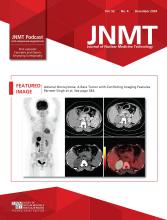RATIONALE
Extracellular deposition of amyloid-β (Aβ) peptides, or plaques, is one of the pathologic hallmarks of Alzheimer disease. Molecular imaging with tracers that bind to Aβ plaques allows in vivo detection of Aβ plaque deposition in the brain. Detection of Aβ deposition may contribute to better diagnosis and management of patients who have cognitive decline and are suspected of having neurodegenerative disorders.
CLINICAL INDICATIONS
Assessment of persistent or progressive unexplained mild cognitive impairment.
Assessment of patients satisfying core clinical criteria for possible Alzheimer disease (i.e., an atypical clinical course or an etiologically mixed presentation).
Evaluation of progressive dementia with an atypical early age of onset.
CONTRAINDICATIONS
Patient agitation or inability to cooperate.
Pregnancy or breastfeeding: pregnancy must be excluded according to local institutional policy; if the patient is breastfeeding, appropriate radiation safety instructions should be provided.
A recent nuclear medicine study (radiopharmaceutical-dependent).
PATIENT PREPARATION/EDUCATION
The patient may eat and take medications as necessary before the procedure.
A focused history containing the following elements should be obtained:
○ Description of symptoms.
○ Neurologic symptoms and history.
○ Current medications.
○ Results of prior imaging studies, including CT, MRI, PET, and SPECT.
PROTOCOL/ACQUISITION INSTRUCTIONS
Obtain access via a short intravenous catheter (∼3.8 cm [1.5 in] or less to minimize adherence to the tubing).
Inject the radiopharmaceutical (Table 1) through the intravenous line as a bolus in a volume of 10 mL or less, and then flush with 10 mL of normal saline. The patient may be seated or reclining when injected.
Wait the appropriate injection to imaging time based on the radiopharmaceutical used.
○ 18F-florbetapir (Amyvid) 30–50 min after injection.
○ 18F-florbetaben (NeuraCeq) 45–130 min after injection.
○ 18F-flutemetamol (Vizamyl) 60–120 min after injection.
Follow the parameters detailed in Table 2.
Have the patient void before images are acquired.
Position the patient supine, with arms down, on the imaging table.
○ Use a head holder to achieve proper positioning and prevent motion.
○ Position the brain, including the cerebellum, in the field of view.
○ Avoid extreme neck extension or flexion.
With minimal interaction, monitor the patient continuously during the procedure.
Radiopharmaceutical Identity, Dose, and Route of Administration
Acquisition Parameters: PET or PET/CT
IMAGE PROCESSING
Remember that processing techniques vary by equipment manufacturer.
Reconstruct the images into transaxial slices of 2- to 4-mm pixel size.
Usually, apply a Hanning or Shepp–Logan filter for reconstruction using filtered backprojection.
For iterative reconstruction, refer to the manufacturer’s recommendations for iterations, subsets, and smoothness.
Display images in the transverse, coronal, and sagittal projections normalized to the maximum intensity of all brain pixels.
Footnotes
↵* Reprinted from Farrell MB, Thomas KS, Mantel ES, Settle J. Quick-Reference Protocol Manual for Nuclear Medicine Technologists, 2nd edition. Society of Nuclear Medicine and Molecular Imaging–Technologist Section. 2024:138–140.







